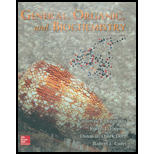
(a)
Interpretation:
Concept introduction:
(a)
Answer to Problem 5MCP
Explanation of Solution
Percent mass/volume is
(b)
Interpretation:
Concept introduction:
(b)
Answer to Problem 5MCP
Explanation of Solution
Given that, the volume and density of solution are
So, mass of solution can be calculated as follows,
Percent mass/mass is
(c)
Interpretation:
Molarity of
Concept introduction:
Molarity can be calculated as follows,
(c)
Answer to Problem 5MCP
Molarity of
Explanation of Solution
Number of moles of magnesium chloride can be calculated as follows,
Therefore molarity of magnesium chloride solution is given below.
Molarity is
(d)
Interpretation:
Molarity of magnesium ion
(d)
Answer to Problem 5MCP
Molarity of magnesium ion
Explanation of Solution
Number of moles of magnesium chloride can be calculated as follows,
Therefore molarity of magnesium ion in solution is given below.
Molarity of magnesium ion is
(e)
Interpretation:
Molarity of chloride ion
(e)
Answer to Problem 5MCP
Molarity of chloride ion
Explanation of Solution
Number of moles of magnesium chloride can be calculated as follows,
Therefore molarity of chloride ion in solution is given below.
Molarity of chloride ion is
(f)
Interpretation:
Osmotic pressure of
Concept introduction:
Osmotic pressure (
Where,
(f)
Answer to Problem 5MCP
Osmotic pressure of
Explanation of Solution
Molarity of magnesium chloride solution is
Given temperature is
The value of universal gas constant is
There will be three ions per mole of the solution, because magnesium chloride dissociates to give one magnesium ion and two chloride ions.
Therefore osmotic pressure can be calculated as follows,
Osmotic pressure is
Want to see more full solutions like this?
Chapter 6 Solutions
GENERAL,ORGANIC,+BIOCHEM.(LL) >CUSTOM<
 ChemistryChemistryISBN:9781305957404Author:Steven S. Zumdahl, Susan A. Zumdahl, Donald J. DeCostePublisher:Cengage Learning
ChemistryChemistryISBN:9781305957404Author:Steven S. Zumdahl, Susan A. Zumdahl, Donald J. DeCostePublisher:Cengage Learning ChemistryChemistryISBN:9781259911156Author:Raymond Chang Dr., Jason Overby ProfessorPublisher:McGraw-Hill Education
ChemistryChemistryISBN:9781259911156Author:Raymond Chang Dr., Jason Overby ProfessorPublisher:McGraw-Hill Education Principles of Instrumental AnalysisChemistryISBN:9781305577213Author:Douglas A. Skoog, F. James Holler, Stanley R. CrouchPublisher:Cengage Learning
Principles of Instrumental AnalysisChemistryISBN:9781305577213Author:Douglas A. Skoog, F. James Holler, Stanley R. CrouchPublisher:Cengage Learning Organic ChemistryChemistryISBN:9780078021558Author:Janice Gorzynski Smith Dr.Publisher:McGraw-Hill Education
Organic ChemistryChemistryISBN:9780078021558Author:Janice Gorzynski Smith Dr.Publisher:McGraw-Hill Education Chemistry: Principles and ReactionsChemistryISBN:9781305079373Author:William L. Masterton, Cecile N. HurleyPublisher:Cengage Learning
Chemistry: Principles and ReactionsChemistryISBN:9781305079373Author:William L. Masterton, Cecile N. HurleyPublisher:Cengage Learning Elementary Principles of Chemical Processes, Bind...ChemistryISBN:9781118431221Author:Richard M. Felder, Ronald W. Rousseau, Lisa G. BullardPublisher:WILEY
Elementary Principles of Chemical Processes, Bind...ChemistryISBN:9781118431221Author:Richard M. Felder, Ronald W. Rousseau, Lisa G. BullardPublisher:WILEY





